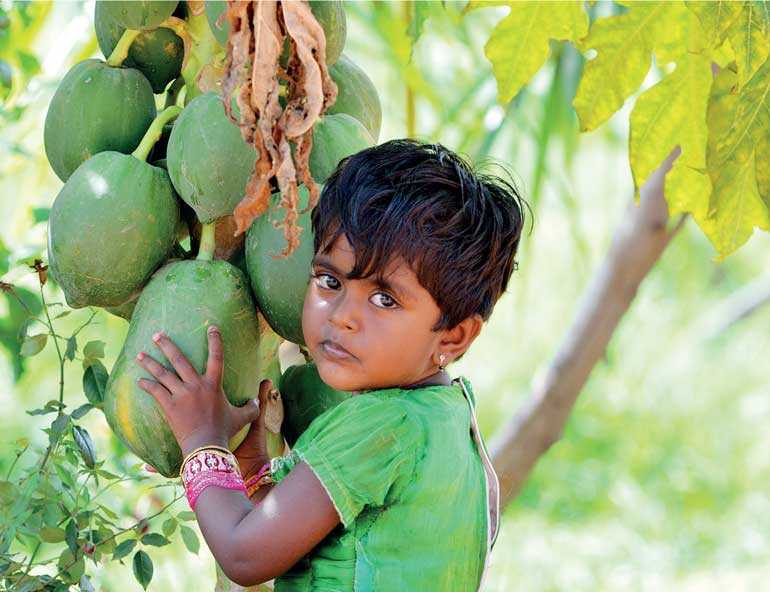Saturday Jan 11, 2025
Saturday Jan 11, 2025
Monday, 25 June 2018 00:00 - - {{hitsCtrl.values.hits}}

Sadly, much remains to be done to ensure children across South Asia can access the nutritious foods they need to live healthy lives – Pic by Shehan Gunasekara
By Idah Z. Pswarayi-Riddihough
In Sri Lanka, as in the rest of South Asia, improving agricultural production has long been a priority to achieve food security.
But growing more crops has hardly lessened the plight of malnutrition.
Chronic malnutrition remains prevalent across the region as many poor South Asians cannot afford nutritious foods or don’t have the relevant information or education to make smart dietary choices.
And children and the poorest are particularly at risk.
South Asia is home to about 62 million of the world’s 155 million children considered as stunted—or too short for their age.
And more than half of the world’s 52 million children identified as wasted—or too thin for their height—live in South Asia.
Moderate-to-severe stunting rates ranged from 17% in Sri Lanka in 2016 to a high 45% in Pakistan in 2012–13, with rates above 30% for most countries in the region.
Moderate-to-severe wasting rates ranged from 2% in Bhutan in 2015 to 21% in India in 2015-16, with rates above 10% for most countries in the region.
The social and economic cost of malnutrition is substantial, linked to impaired cognitive development, chronic disease, and lower future earnings.
And sadly, much remains to be done to ensure children across South Asia can access the nutritious foods they need to live healthy lives.
The World Health Organization’s global targets for 2025 aims to reduce the number of stunted children by 40% and curb the child wasting rate to less than 5%.
Bangladesh and India have seen modest average declines in stunting of 1% per year. Pakistan and Sri Lanka have experienced no decline.
Equally alarming, all South Asian countries are predicted to be off course in reducing wasting.
What’s striking about South Asia—and unique compared to the rest of the developing world—is how stubborn chronic malnutrition remains despite high economic growth.
What explains this disconnect?
The first hypothesis is that governments do not commit enough to improve food, water, sanitation, care, and health services that can help improve nutrition outcomes amid disadvantaged populations.
On the demand side, poor families usually underinvest in nutritious foods due to cost, nonmonetary constraints, or traditional beliefs and preferences.
To find solutions and stimulate behavioural changes for better nutrition, the World Bank’s South Asia Food and Nutrition Security Initiative (SAFANSI) will gather this week experts on food systems and nutrition, international donors and civil society at a regional roundtable in Colombo.
The event will discuss how consumers interact with food systems, how markets affect their dietary preferences and consumption, and how government policies can enable or distort nutrition-sensitive food markets.
Later this year, the World Bank will publish the flagship report Ending Malnutrition in South Asia that examines the underlying factors behind South Asia’s high levels of undernutrition as well as slow progress in reducing undernutrition.
This study will also put forth recommendations to design policies and actions to address undernutrition.
This effort will require a multi-pronged approach as inadequate dietary intake depends on improving aggravating circumstances in water and sanitation, education, economic livelihoods, agriculture and food, and the status of women.
So far, South Asian governments have yet to effectively tackle the immense burden of undernutrition.
To be true, government and the private sector can—and should—help meet the demand for more nutritious foods.
But ultimately, consumers’ tastes and dietary choices will drive the demand for better foods.
As such, equipping individuals with the information they need to make good food choices and adopt healthier behaviours will have a more lasting impact.
Fittingly, this week’s timely roundtable ‘Putting the Lens on the Consumer’ will provide the knowledge, resources, and tools needed to pave the way for optimum nutrition for all South Asians.
(The author is the World Bank Country Director for Sri Lanka and the Maldives.)